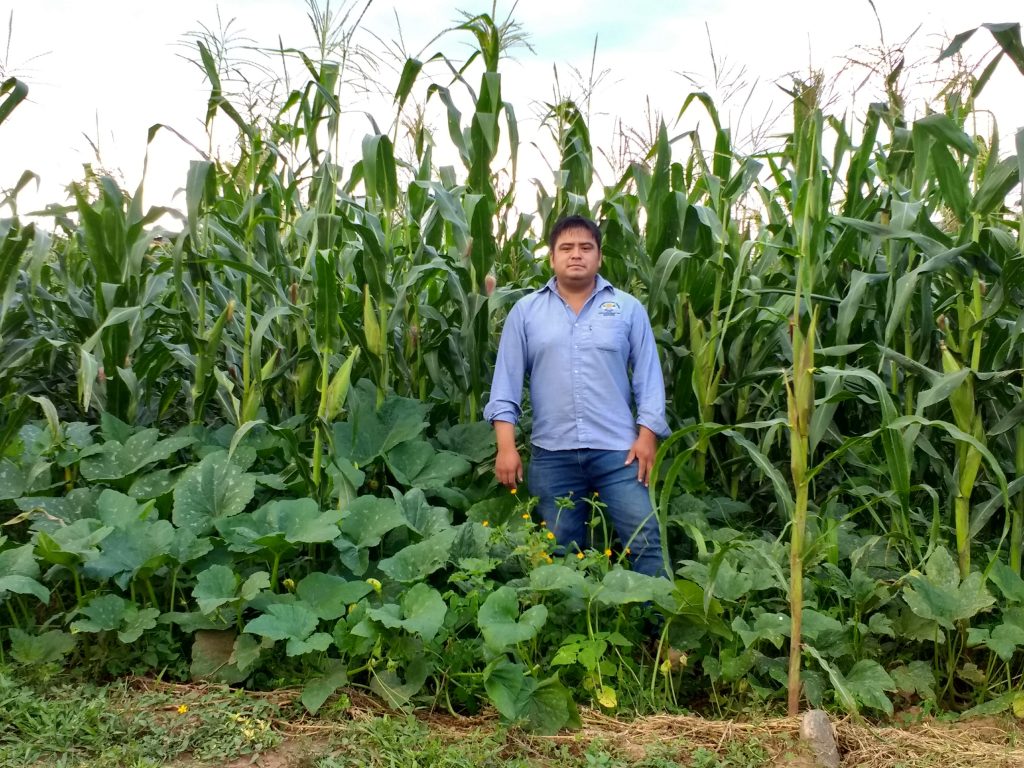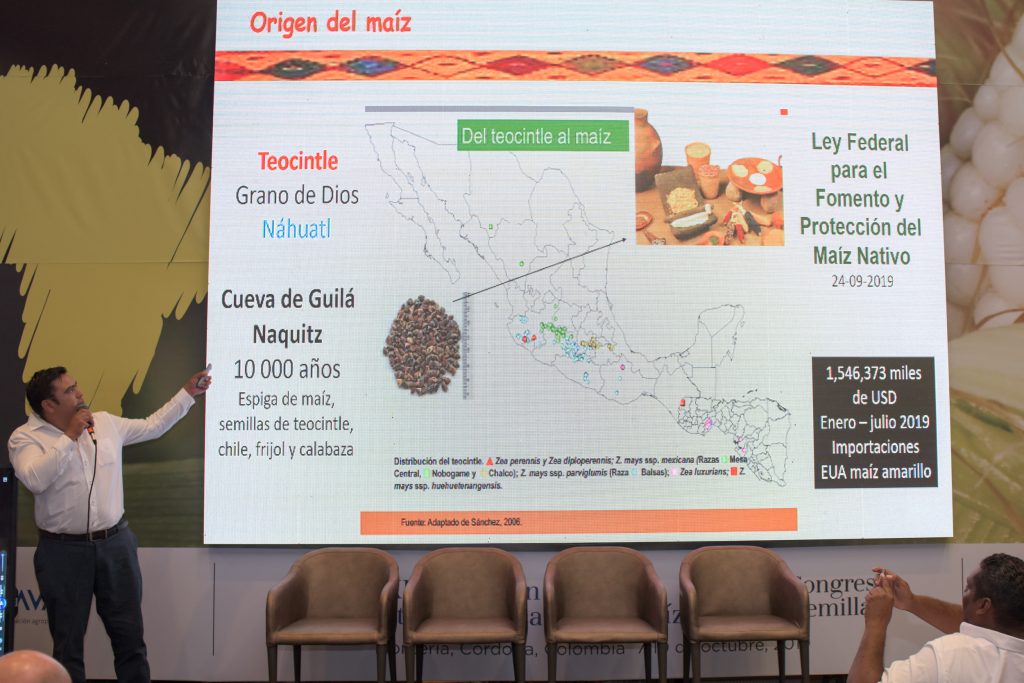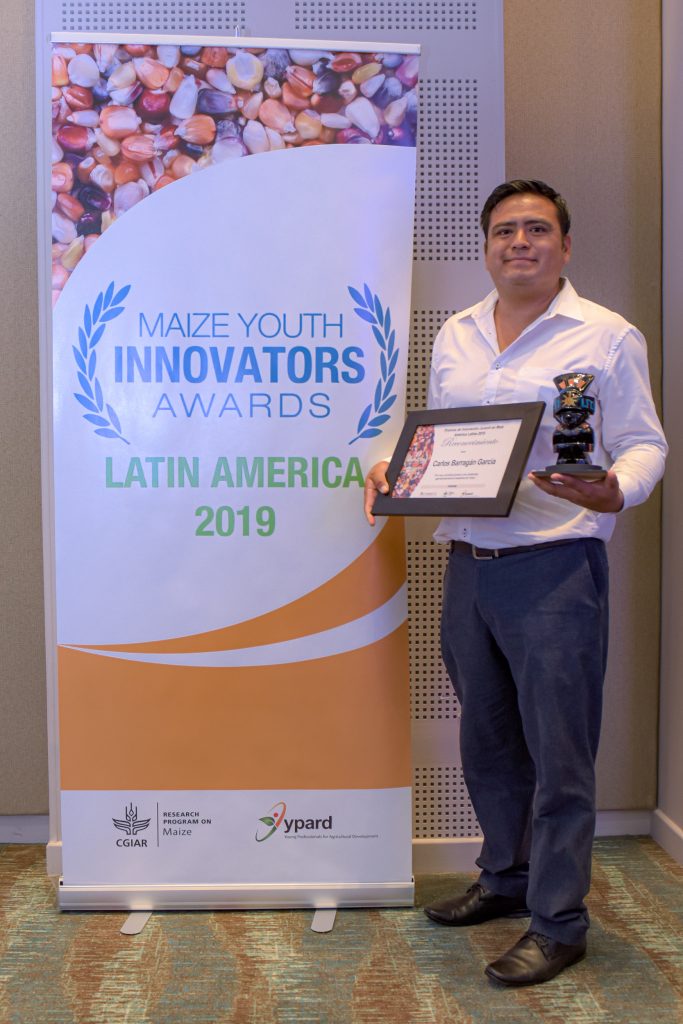Young innovator Carlos Barragan García is implementing sustainable maize systems for smallholder farmers
By Leslie Dominguez and Jennifer Johnson
Carlos Barragan García works on soil fertility as well as inclusive business models for smallholder farmers working in maize agri-food value chains. He has a degree in agroecological engineering from Chapingo Autonomous University and collaborates with the MasAgro project in Mexico’s state of Oaxaca. Barragan was recently awarded the MAIZE Youth Innovators Award 2019 – Latin America in the category of change agent for his involvement in this work.
The awards, an initiative of the CGIAR Research Program on Maize (MAIZE), seek to recognize the contributions of young women and men who are implementing innovations in Latin American maize-based agri-food systems. This is the third instalment of the awards, following Asia in October 2018 and Africa in May 2019. The awards ceremony took place at the 23rd Latin American Maize Reunion in Monteria, Colombia on October 9, 2019.

Q: What inspired you to work in agriculture?
A: My great-grandfather was a farmer, he used to plant maize in a town called Zapotitlán Salinas in the semi-arid region of the state of Puebla, Mexico. I remember that in the last years of his life something happened in his fields and his production went down, he wasn’t able to harvest anything, unlike when I was a child and we used to go to the field to (shell) the corn and eat maize ears, in that time there were much higher yields.
I have always believed that this could be improved, and thought that it wasn’t fair that my grandfather, who had dedicated his entire life to maize farming, couldn’t have that satisfaction at the end of his life to harvest as much as he had before.
Several of my schoolmates and I had the opportunity to study at Chapingo Autonomous University, and I chose to study agroecology in the hope that I could help my grandfather to improve his production system and maize yields.
When I started to learn more about agronomy, I visited my grandfather and I made recommendations that could help him to improve his maize production. Sometimes he would not accept my advice because the methods seemed too expensive. That is when I decided to change my focus to work to help farmers find less expensive alternatives that would help them to achieve better yields and receive additional benefits on their farm as well.

Q: Tell us about your innovation?
My innovation came about through the work I have done over the past few years with the Pacific hub of the MasAgro project, a joint initiative between the International maize and Wheat Improvement Center (CIMMYT) and Mexico’s Secretariat of Agriculture and Rural Development. The innovation consists of helping farmers to adapt their small scale production systems to climate change, as well as improving soil fertility through crop rotation and diversification to achieve a sustainable increase in maize production.
In 2016 we started to work with native maize from the central valleys of Oaxaca, Mexico, where the majority of agriculture is traditional, there is low use of inputs and they have been losing soil fertility. In 2017 we started to promote crop rotations with legumes through the establishment of “crop showcases”: we planted strips of legumes and grasses and held a demonstrative event with farmers during the grain filling stage so that they could evaluate the performance of each crop. In 2018 we started to look for other crop alternatives that could help us increase phosphorous in the soil, we tried soy, sunflower and canola.
There are farmers we have been working with since 2016 that have managed to go from producing only 600kg/ha of native landrace white maize of the “bolita” variety to producing 4 ton/ha, and up to 2.5 ton/ha for yellow or black “bolita” maize varieties. In addition, these farmers gain a second crop such as garbanzo beans, sunflower, canola, beans, squash, amaranth, vetch, triticale, wheat, or pea.
Most maize produced in Oaxaca is white, but pigmented maize such as red and blue contain antioxidants such as anthocyanin, so we began to work with pigmented maize to help improve the nutrition of the families we work with. However, as these types of maize are not as commonly consumed in Oaxaca, these families had a hard time selling their surplus maize grain. We started working with a local farmer organization to create an inclusive business model for small maize farmers, and in 2019 they established the first native maize tortilleria (tortilla factory and store) in the city of Oaxaca, Mexico, called Xúb Maíz. Five of the farmers we work with that have had excess maize grain have started to sell to them, which has motivated more farmers to adopt innovations to sustainably increase their own maize production and yields.

Q: How does it feel to be a winner of the MAIZE Youth Innovators Awards?
A: I feel so grateful. I have reflected a lot about what it means to be here in Colombia, at the 23rd Latin American Maize Reunion and to be named one of the winners of the winners of the MAIZE Youth Innovators Awards 2019 – Latin America and I know that I am so fortunate. Many of the people I went to elementary school with were not able to go to University, and even those who could do not always have the chance to work in what they are passionate about. The fact that I have the possibility to work doing what I really love, through the support of my family, friends and colleagues that have helped me to grow professionally to be able to offer better alternatives to farmers, truly means so much to me. I am very happy to have had the opportunity to come here and learn from scientists with so many years of experience in maize production and hear about their work in Latin America. I have learned so much and am excited to go back home and try out everything that I have learned here.
Q: What advice do you have for other young people interested in agriculture?
A: There is a huge demand for food, and it is necessary that young people get involved in food systems because they are going to be the scientists, engineers and farmers that will feed the world in the future. It is also important that more young women enter agriculture, especially in Mexico as many men have had to migrate for work and we are seeing more and more women working in the fields. Women need to be empowered so that together we can work for better systems and innovations that will help us reach the goal of feeding the world by 2050.

2019 MAIZE Youth Innovators Awards, 2019 MAIZE Youth Innovators Awards Latin America, Latin America, Maize, Mexico, MYIA 2019, MYIA 2019 Latin America
